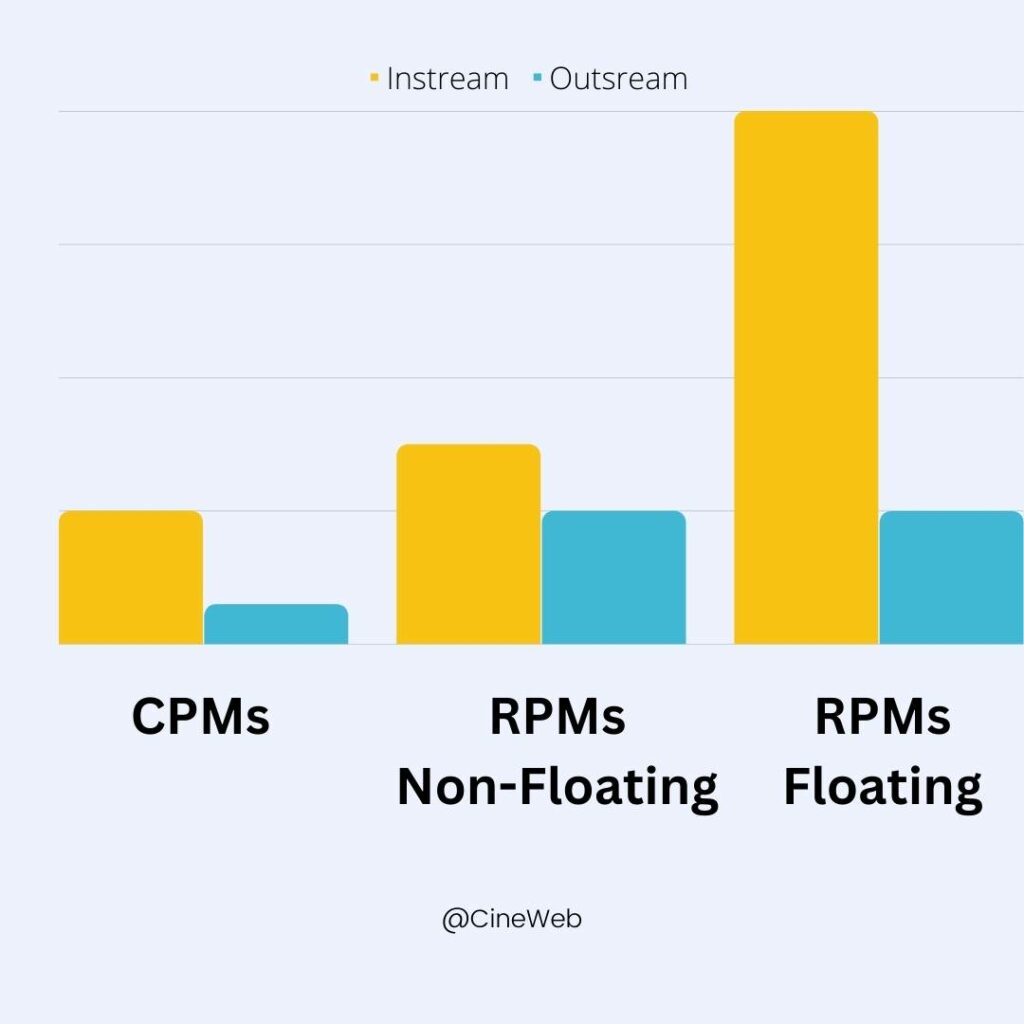
Unleashing the Power of Outstream Ads: A Comprehensive Guide for Website Publishers
I. Introduction
Outstream video ads are a dynamic and effective way for website publishers to monetize their content and engage their audience. They are very useful when website publishers don’t or cannot use floating instream ad units, which have the highest revenue potential. What exactly are outstream video ads, and how can they benefit website publishers?

According to IAB: “Out-stream video ads (also spelled as outstream ads or out stream ads) are usually served alone with their own player in a display
placement. Various terms have been used to define out-stream, including:
• In-banner video
• In-page video
• Rich media (banner with video)
• Video interstitial
• Incentivized video
• In-feed video”
a. What are outstream video ads anyway: Outstream video ads are a type of digital advertising that play a video ad on a webpage outside of the boundaries of a traditional video player. These ads can appear anywhere on a webpage and are triggered to play as a user scrolls through content. Outstream video ads are designed to capture the attention of web users and encourage them to interact with the ad.
b. Overview of the benefits of outstream video ads for website publishers: As a website publisher, integrating outstream video ads into your content can provide a number of benefits. First and foremost, outstream video ads offer an opportunity to monetize your website through ad placements. By hosting outstream video ads, you can generate revenue from your website traffic. In addition to providing a financial benefit, outstream video ads can also improve the user experience on your website. Outstream video ads can help to engage and retain users on your site by offering targeted, relevant advertising to your audience. Staying up-to-date on the latest advertising trends and implementing outstream video ads, website publishers can tap into the full potential of this powerful advertising medium.
c. The differences between outstream ads and instream ads: Outstream video ads and instream video ads are two distinct types of digital advertising that are often used by website publishers. While both types of ads play videos on a webpage, there are several key differences between outstream and instream ads that website publishers should be aware of.
One of the main differences between outstream and instream ads is the location in which they are displayed. Outstream video ads are triggered to play as a user scrolls through content on a webpage and can appear anywhere on the page. In contrast, instream video ads are played within the boundaries of a traditional video player and are typically displayed at the beginning or middle of a video.
Another key difference between outstream and instream ads is the user experience. Outstream video ads are designed to capture the attention of web users as they scroll through content, while instream video ads are typically played in a more controlled environment within a video player. As a result, outstream video ads may be more disruptive to the user experience, while instream video ads may be less disruptive but also less noticeable.
The most important difference is that a well-placed floating instream ad unit will perform much higher than any outstream ad unit:

According to an academic research, instream ads are more popular: “Although the new format of video ads, outstream, is becoming increasingly popular in the industry, extant research focuses mainly on instream video ads.” Source: Yu, Yifan and Wang, Yingfei and Zhang, Guangyu and Zhang, Zuohua and Wang, Chu and Tan, Yong, Outstream Video Advertisement Effectiveness (May 1, 2022). Available at SSRN: https://ssrn.com/abstract=4098246 or http://dx.doi.org/10.2139/ssrn.4098246.
II. Types of Outstream Video Ads
Outstream video ads come in a variety of formats and can be integrated into different areas of a website. As a website publisher, it’s important to understand the different types of outstream video ads available and how each can be utilized to best serve your audience and monetize your content.
a. In-banner video ads: In-banner video ads are outstream video ads that are placed within the banner of a webpage. These ads are triggered to play as a user scrolls through content and are often displayed at the top or bottom of the webpage. In-banner video ads are a good option for website publishers looking to monetize their content without disrupting the user experience.
b. In-feed video ads: In-feed video ads are outstream video ads that are placed within the content feed of a webpage. These ads are triggered to play as a user scrolls through the feed and are often integrated seamlessly into the content. In-feed video ads are a good option for website publishers looking to monetize their content and provide relevant, targeted advertising to their audience.
c. In-article video ads: In-article video ads are outstream video ads that are placed within the body of an article or blog post. These ads are triggered to play as a user scrolls through the article and are often integrated seamlessly into the content. In-article video ads are a good option for website publishers looking to monetize their content and provide relevant, targeted advertising to their audience.
In-article and in-feed video ads are easy to implement and they can contribute to website revenue significantly.
d. Other outstream video ad formats: In addition to the above formats, there are several other options for outstream video ads. These include in-image video ads, which are triggered to play when a user hovers over an image, and floating video ads, which appear as a separate window on the webpage and can be minimized by the user. Publishers should consider which outstream video ad formats will best suit their content and audience and which ones will bring in the highest revenue.
III. Placing Outstream Video Ads on a Website
Website publishers carefully consider the placement and appearance of outstream video ads on their website. By following best practices and optimizing the placement and appearance of ads, they can maximize the effectiveness of your outstream video ad campaigns and provide positive user experiences.
Best practices for integrating outstream video ads into website content:
- Ensure that outstream video ads are integrated seamlessly into your website content. These ads should blend in with the surrounding content and not disrupt the user experience.
- Use outstream video ads to complement your content, rather than distract from it. By offering relevant, targeted advertising to your audience, you can enhance the user experience on your site.
- Consider the frequency of outstream video ads on your website. Too many ads can be disruptive and negatively impact the user experience, while too few ads may not generate sufficient revenue. Finding the right balance is key.
Tips for optimizing the placement and appearance of outstream video ads:
- Experiment with different ad placements to find the most effective location for your outstream video ads. Consider factors such as the layout of your website, the type of content you offer, and the demographics of your audience.
- Pay attention to the size and appearance of your outstream video ads. Advertisements that are too large or intrusive can be off-putting to users, while ads that are too small or subtle may not be effective.
- Use A/B testing to determine the optimal placement and appearance of your outstream video ads. By comparing the performance of different ad configurations, you can identify the most effective options for your website.
Following best practices and optimizing the placement and appearance of outstream video ads lead to website publishers to be able to effectively monetize their content and improve the user experience on their site.
IV. Measuring the Effectiveness of Outstream Video Ads
Website publishers should track and analyze the performance of your outstream video ad campaigns in order to continuously optimize and improve their revenue. There are a variety of key metrics and tools available to help you evaluate the performance of your outstream video ads and identify areas for improvement.
a. Key metrics for evaluating the performance of outstream video ads: There are several key metrics that can help you evaluate the performance of your outstream video ads. These include:
- Impression rate: The percentage of website visitors who see your outstream video ad.
- Click-through rate (CTR): The percentage of website visitors who click on your outstream video ad.
- Conversion rate: The percentage of website visitors who take a desired action (such as making a purchase) after clicking on your outstream video ad.
- Cost-per-impression (CPM): The cost of your outstream video ad campaign on a per-impression basis.
- Cost-per-click (CPC): The cost of your outstream video ad campaign on a per-click basis.
b. Tools and techniques for tracking and analyzing outstream video ad performance: There are several tools and techniques available for tracking and analyzing the performance of your outstream video ads. These include:
- Ad tracking and analytics platforms: These platforms, such as Google Ad Manager, Google Analytics, provide detailed insights into the performance of your outstream video ad campaigns.
- A/B testing: By comparing the performance of different outstream video ad configurations, you can identify the most effective options for your website.
- User feedback and surveys: Gathering feedback from your website visitors can provide valuable insights into the effectiveness of your outstream video ads.
Tracking and analyzing the performance of your outstream video ads will regard you identify areas for improvement and optimize your campaigns for maximum effectiveness.
V. Maximizing Revenue from Outstream Video Ads
Maximizing ad revenue from outstream video ads is likely a top priority for website publishers. By implementing effective strategies and best practices, you can optimize the revenue potential of your outstream video ad campaigns.
a. Strategies for maximizing ad revenue from outstream video ads: There are several strategies that can help you maximize ad revenue from outstream video ads. These include:
- Utilizing data and analytics to target the most valuable audiences and optimize ad placements.
- Offering a range of ad formats and placements to appeal to different advertisers.
- Utilizing demand-side platforms (DSPs) to access a wider range of advertisers and optimize ad bids.
- Implementing ad retargeting to reach users who have previously engaged with your website or outstream video ads.
- Choosing the best ad network such as CineWeb Media. We are here to maximize your ad revenue and configure the best ad setup for your website.
b. Best practices for pricing and selling outstream video ad inventory: In order to maximize ad revenue from outstream video ads, it’s important to have a clear pricing and selling strategy in place. Some best practices to consider include:
- Establishing clear pricing tiers based on ad format, placement, and audience targeting.
- Offering flexible pricing options, such as cost-per-impression (CPM) or cost-per-click (CPC) pricing, to appeal to a range of advertisers.
- Utilizing real-time bidding (RTB) to optimize ad prices in real-time based on demand.
- Regularly reviewing and adjusting ad prices to ensure that you are maximizing revenue potential.
VI. Challenges and Considerations for Website Publishers
As with any advertising medium, website publishers may encounter a range of challenges and issues when implementing outstream video ads on their websites. Understanding and addressing these challenges, publishers can ensure the success of their outstream video ad campaigns.
a. Common challenges and issues that website publishers may encounter when using outstream video ads:
- Ad blocking software: Some users may have ad blocking software installed on their devices, which can prevent outstream video ads from being displayed.
- Ad fatigue: If users are exposed to too many outstream video ads, they may become less engaged and less likely to interact with your ads.
- Ad quality: Poorly designed or low-quality outstream video ads may be less effective and may negatively impact the user experience.
- Integration with website content: Ensuring that outstream video ads are integrated seamlessly into your website content can be a challenge.
- Traffic quality (i.e., preventing the invalid traffic) will directly effect the performance of outsream ads. Preventing the invalid traffic and filtering low quality traffic from non-reputable sources will increase the ad revenue.
b. Tips for overcoming these challenges and ensuring a successful outstream video ad campaign:
- Use ad tracking and analytics platforms to monitor the performance of your outstream video ads and identify areas for improvement.
- Experiment with different ad placements and formats to find the most effective options for your website.
- Use A/B testing to compare the performance of different ad configurations and identify the most effective options.
- Regularly review and optimize your outstream video ad campaigns to ensure that they are performing at their best.
VII. Conclusion
Outstream video ads are a powerful and effective advertising medium for website publishers looking to monetize their content and engage their audience. Understanding the types of outstream video ads available and implementing best practices for placement and optimization, website publishers can maximize the effectiveness and revenue potential of these ads. Moreover, tracking and analyzing ad performance and addressing common challenges regards website publishers ensure the success of their outstream video ad campaigns.
Looking to the future, it’s likely that the outstream video ad market will continue to evolve and innovate. As new technologies and trends emerge, website publishers will need to stay up-to-date and adapt their strategies in order to remain competitive and capitalize on the full potential of outstream video ads.
FAQ
An outstream ad is a type of digital advertising that plays a video ad on a webpage outside of the boundaries of a traditional video player. These ads can appear anywhere on a webpage and are triggered to play as a user scrolls through content. Outstream ads are designed to capture the attention of web users and encourage them to interact with the ad. Outstream ads are typically used by website publishers to monetize their content and engage their audience.
Instream ads and outstream ads are two types of digital advertising that involve the display of video ads on a webpage or app.
Instream ads are played within the boundaries of a traditional video player and are typically displayed at the beginning or middle of a video. These ads are often used by website publishers to monetize their video content and provide relevant, targeted advertising to their audience.
Outstream ads, on the other hand, are triggered to play as a user scrolls through content on a webpage and can appear anywhere on the page. Outstream ads are designed to capture the attention of web users and encourage them to interact with the ad. These ads are typically used by website publishers to monetize their content and engage their audience.
In summary, instream ads and outstream ads are both types of digital advertising that involve the display of video ads on a webpage, but they differ in terms of the location and context in which they are displayed.
Outstream ads can be either skippable or non-skippable, depending on the specific ad format and the preferences of the advertiser. Some outstream ad formats, such as in-banner video ads or in-feed video ads, may be skippable after a certain period of time has elapsed. Other outstream ad formats, such as in-article video ads or floating video ads, may not be skippable.
As a website publisher, it’s important to understand the specific ad formats and features that are available for outstream ads and to consider which options will best suit your needs and goals. Some website publishers may prefer skippable outstream ads in order to minimize disruption to the user experience, while others may prefer non-skippable outstream ads in order to maximize ad revenue. Ultimately, the choice of whether to use skippable or non-skippable outstream ads will depend on the specific needs and goals of the website publisher and the preferences of the advertiser.
Whether or not a website publisher gets paid for outstream ads that are skipped by users depends on the specific ad format and the terms of the ad campaign. Some outstream ad formats, such as in-banner video ads or in-feed video ads, may be skippable after a certain period of time has elapsed. In these cases, the website publisher may still receive payment for the ad even if it is skipped by the user.
Other outstream ad formats, such as in-article video ads or floating video ads, may not be skippable. In these cases, the website publisher would not receive payment if the ad is skipped by the user.
CineWeb uses ads that pay after 6 seconds of view and the skip button appears after the 6th second. Thus the view will be rewarded even if skipped.






